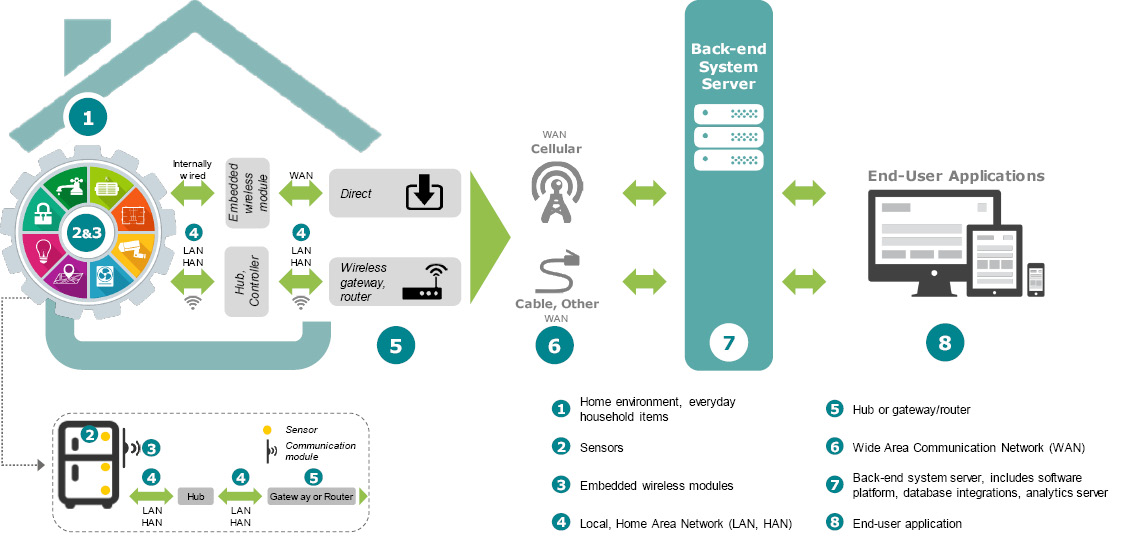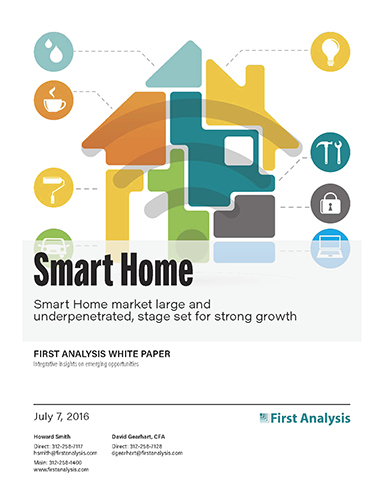White paper: Smart Home
Smart Home market large and underpenetrated, stage set for strong growth

We are expanding our research on the Internet of Things (IoT) to include Smart Home, a market we expect to reach $18B in the U.S. alone by 2025, up from 2015’s $3.5B (and a current penetration rate of less than 10%) and representing a 17.5% CAGR.
Consumers have historically been slow to adopt connected device technologies in the home environment, but we think the stage is finally set for this to change, driven by the dissemination of smartphones, the growth and expansion of broadband networks, increasing interoperability among vendors, improving consumer awareness, and cheaper point solutions that are both easy to use and install relative to historical systems.
The Smart Home market is crowded, featuring hundreds of players with a variety of offerings and business models. In the short term, we believe many will enjoy strong growth stemming from a focus on the right initial vertical to support a land-and-expand strategy, being open and fostering interoperability, meeting the market’s ease-of-use requirements, and bridging the gap between the high prices of Smart Home products and their traditional counterparts with thoughtful messaging on their relative benefits.
Longer term, we expect the most successful companies in Smart Home to be those that occupy a position as the home’s central hub or platform given what it means for add-on sales opportunities, customer stickiness, and the creation and monetization of emerging services. This report provides a high-level overview of the Smart Home market, beginning with a description of basic solutions and their components. We then look at industry history, use cases, potential benefits, market size, growth expectations, and factors driving adoption. In addition, we segment the market in a variety of areas and outline the attributes we expect successful companies in the space to exhibit in the near and long term. After this overview, we profile some key players.
TABLE OF CONTENTS
Includes profiles of 18 public and private companies
- What is a Smart Home?
- Benefits
- History
- Why Smart Home adoption has been limited to date
- Why now? What’s changed? A look at key adoption drivers
- Our focus in the Smart Home
- Sizing the Smart Home market opportunity
- Segmenting the market
- Customers
- Competitive backdrop – market features hundreds of players, number still rising
- Business models
- Distribution, channels to market
- Success drivers
- Highlighted Smart Home company
- Private and public company profiles
What is Smart Home
Smart Home. Connected Home. Home Automation. Interactive Home. From a high level, these terms essentially describe the same thing, solutions where residences and/or everyday household items are equipped with sensors and wireless networking hardware to facilitate remote monitoring and control as well as automation. Users can access home infrastructure and electronics data and settings in real time through a web-based interface supported by smartphones (apps), tablets, and PCs. Smart Home solutions and systems are being adopted by consumers for a variety of reasons, including to increase home safety/security, optimize energy/resource consumption, automate processes and drive efficiencies, improve wellness, and increase situational awareness.
Overview of a solution
A Smart Home solution typically consists of a handful of components, which we illustrate in Table 1. These include: 1) a home or household item to be monitored/controlled, 2) sensors placed around the home or in items to capture data, 3) embedded wireless modules to transmit collected data locally (often using a proprietary communication protocol) over 4) a home or local area network (HAN, LAN), 5) a hub or gateway device that passes the aggregated data through 6) a long-range communication network (cellular, long-range/low-power, cable) to 7) a back-end system (software platform) where the data is processed and analyzed, turning it into actionable information reviewable through 8) an end-user application that a customer can access on the Internet via a control device such as a mobile handset, tablet, or PC.
TABLE 1: Components of a Smart Home solution

Source: First Analysis.
Notes: LAN: Local Area Network; HAN: Home Area Network; WAN: Wide Area Network.
We note in some cases the wireless hardware doesn’t leverage a local network or hub/gateway, instead passing the data directly to the back end through a wide area network (WAN); this approach isn’t common currently but is gaining some popularity as wireless hardware costs decline. The hardware components noted above have firmware (basic software) embedded to enable specific functionality, and most devices support two-way communication, being able to transmit data in addition to receiving data (instructions, updates) from the back-end system.

Request full report
To access the full report, please provide your contact information in the form below. Thank you for your interest in First Analysis research.
